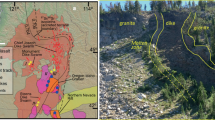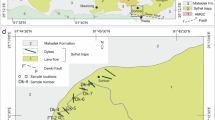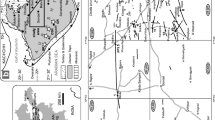Abstract
Recent studies of large mafic dyke swarms in the Deccan Traps flood basalt province, India, indicate that some of the correlative lava flows reached several hundred kilometers in length. Here we present field, petrographic, mineral chemical, and whole-rock geochemical (including Sr-Nd isotopic) data on the Palitana lava sequence and nearby dykes in the Saurashtra region of the northwestern Deccan Traps. These rocks are moderately evolved, many with low-Ti-Nb characteristics. We infer that most dykes are notably (and systematically) less contaminated by ancient continental crust than the Palitana flows, but four dykes are equally or significantly more contaminated, with some of the most extreme Sr-Nd isotopic compositions seen in the entire Deccan Traps (initial εNd is as low as −18.0). A Bhimashankar-type and a Poladpur-type dyke are present several hundred kilometers from the type section of these magma types in the Western Ghats escarpment. We find no geochemical correlations between the Palitana sequence and three subsurface sequences in NE Saurashtra containing abundant picritic rocks, surface lavas previously studied from Saurashtra, or the Western Ghats sequence. Intriguingly, the Eastern Saurashtra dykes cannot have been feeders to any of these lava sequences. Feeder dykes of these sequences may be located in southwestern or central Saurashtra, or in the Dhule-Nandurbar-Dediapada areas across the Gulf of Cambay, 200–300 km east of Palitana. Our results indicate polycentric flood basalt eruptions not only on the scale of the Deccan Traps province, but also within the Saurashtra region itself.











Similar content being viewed by others
References
Auden JB (1949) Dykes in western India—a discussion of their relationships with the Deccan Traps. Trans Nat Acad Sci Ind 3:123–157
Beane JE (1988) Flow stratigraphy, chemical variation and petrogenesis of Deccan flood basalts from the Western Ghats, India. PhD Dissertation, Washington State Univ, USA
Beane JE, Turner CA, Hooper PR, Subbarao KV, Walsh JN (1986) Stratigraphy, composition and form of the Deccan basalts, Western Ghats, India. Bull Volcanol 48:61–83
Bhattacharji S, Chatterjee JM, Wampler JM, Nayak PN, Deshmukh SS (1996) Indian intraplate and continental margin rifting, lithospheric extension, and mantle upwelling in Deccan flood basalt volcanism near the K/T boundary: evidence from mafic dyke swarms. J Geol 104:379–398
Bondre NR, Hart WK, Sheth HC (2006) Geology and geochemistry of the Sangamner mafic dyke swarm, western Deccan volcanic province, India: implications for regional stratigraphy. J Geol 114:155–170
Bose MK (1973) Petrology and geochemistry of the igneous complex of Mount Girnar, Gujarat, India. Contrib Mineral Petrol 39:247–266
Bowen NL (1928) The evolution of the igneous rocks. Princeton University Press, Princeton, p 334
Chandrasekharam D, Mahoney JJ, Sheth HC, Duncan RA (1999) Elemental and Nd-Sr-Pb isotope geochemistry of flows and dykes from the Tapi rift, Deccan flood basalt province, India. J Volcanol Geotherm Res 93:111–123
Chatterjee SK (1932) Igneous rocks from west Gir forest, Kathiawar. J Geol 40:155–160
Chatterjee N, Bhattacharji S (2001) Origin of the felsic and basaltic dykes and flows in the Rajula-Palitana-Sihor area of the Deccan Traps, Saurashtra, India: a geochemical and geochronological study. Int Geol Rev 43:1094–1116
Chatterjee N, Bhattacharji S (2004) A preliminary geochemical study of zircons and monazites from Deccan felsic dykes, Rajula, Gujarat, India: implications for crustal melting. In: Sheth HC, Pande K (eds) Magmatism in India through time. Proc Ind Acad Sci (Earth Planet Sci) 113:533–542
Cox KG, Hawkesworth CJ (1984) Relative contributions of crust and mantle to flood basalt magmatism, Mahabaleshwar area, Deccan Traps. Phil Trans R Soc Lond A310:627–641
Cox KG, Hawkesworth CJ (1985) Geochemical stratigraphy of the Deccan Traps at Mahabaleshwar, Western Ghats, India, with implications for open system magmatic processes. J Petrol 26:355–377
DePaolo DJ (1981) Trace element and isotopic effects of combined wall rock assimilation and fractional crystallization. Earth Planet Sci Lett 53:189–202
DePaolo DJ (1987) Neodymium isotope geochemistry: an introduction. Springer, New York, 198 p
Deshmukh SS, Sehgal MN (1988) Mafic dyke swarms in Deccan volcanic province of Madhya Pradesh and Maharashtra. In: Subbarao KV (ed) Deccan flood basalts. Geol Soc Ind Mem 10:323–340
De A (1981) Late Mesozoic–Lower Tertiary magma types of Kutch and Saurashtra. In: Subbarao KV, Sukheswala RN (eds) Deccan volcanism. Geol Soc Ind Mem 3:327–339
Devey CW, Lightfoot PC (1986) Volcanological and tectonic control of stratigraphy and structure in the western Deccan Traps. Bull Volcanol 48:195–207
Erlank AJ, Marsh JS, Duncan AR, Miller RM, Hawkesworth CJ, Betton PJ, Rex DC (1984) Geochemistry and petrogenesis of the Etendeka volcanic rocks from Southwest Africa/Namibia. Spec Publ Geol Soc S Afr 13:195–245
Faure G (1986) Principles of isotope geology, 2nd ed. Wiley, Hoboken, 608 p
Fedden F (1884) The geology of the Kathiawar Peninsula in Gujarat. Geol Surv Ind Mem 21:2
Fisk MR, Upton BGJ, Ford CE, White WM (1988) Geochemical and experimental study of the genesis of magmas of Réunion Island, Indian Ocean. J Geophys Res 93:4933–4950
Guarino V, Azzone RG, Brotzu P, Gomes CB, Melluso L, Morbidelli L, Ruberti E, Tassinari CCG, Brilli M (2012) Magmatism and fenitization in the Cretaceous potassium–alkaline–carbonatitic complex of Ipanema São Paulo State, Brazil. Mineral Petrol 104:63–61
Gudmundsson A, Marinoni LB (2002) Geometry, emplacement, and arrest of dykes. Annal Tecto 13:71–92
Hergt JM, Peate DW, Hawkesworth CJ (1991) The petrogenesis of Mesozoic Gondwana low-Ti flood basalts. Earth Planet Sci Lett 105:134–148
Hooper PR, Widdowson M, Kelley S (2010) Tectonic setting and timing of the final Deccan flood basalt eruptions. Geology 38:839–842
Khadri SFR, Subbarao KV, Hooper PR, Walsh JN (1988) Stratigraphy of the Thakurvadi Formation, western Deccan basalt province, India. In: Subbarao KV (ed) Deccan flood basalts. Geol Soc Ind Mem 10:280–304
Krishnamacharlu T (1971) Dykes around Dadiapada, Broach district, Gujarat. Bull Volcanol 35:947–956
Krishnamacharlu T (1972) Petrology of picrodolerites from the Dedan cluster, Gujarat. J Geol Soc Ind 13:262–272
Krishnamurthy P, Cox KG (1977) Picrite basalts and related lavas from the Deccan Traps of western India. Contrib Mineral Petrol 62:53–75
Krishnamurthy P, Gopalan K, Macdougall JD (2000) Olivine compositions in picrite basalts and the Deccan volcanic cycle. J Petrol 41:1057–1069
Krishnan MS (1926) The petrography of rocks from the Girnar and Osham hills, Kathiawar. Geol Surv Ind Rec 58:380
Kshirsagar PV, Sheth HC, Seaman SJ, Shaikh B, Mohite P, Gurav T, Chandrasekharam D (2012) Spherulites and thundereggs from pitchstones of the Deccan Traps: geology, petrochemistry, and emplacement environments. Bull Volcanol 74:559–577
Le Bas MJ, Le Maitre RW, Streckeisen A, Zanettin P (1986) A chemical classification of volcanic rocks based on the total alkali-silica diagram. J Petrol 27:745–750
Lepage LD (2003) ILMAT: an Excel worksheet for ilmenite–magnetite geothermometry and geobarometry. Comput Geosci 29:673–678
Lightfoot PC, Hawkesworth CJ (1988) Origin of Deccan Trap lavas: evidence from combined trace element and Sr-, Nd- and Pb-isotope studies. Earth Planet Sci Lett 91:89–104
Lightfoot PC, Hawkesworth CJ, Devey CW, Rogers NW, Van Calsteren PWC (1990) Source and differentiation of Deccan Trap lavas: implications of geochemical and mineral chemical variations. J Petrol 31:1165–1200
Macdougall JD (1986) Isotopic composition of Deccan and ocean ridge basalts: implications for their mantle sources. J Geol Soc Ind 27:38–46
Mahoney JJ, Macdougall JD, Lugmair GW, Murali AV, Sankar Das M, Gopalan K (1982) Origin of the Deccan trap flows at Mahabaleshwar inferred from Nd and Sr isotopic and chemical evidence. Earth Planet Sci Lett 60:47–60
Mahoney JJ, Sheth HC, Chandrasekharam D, Peng ZX (2000) Geochemistry of flood basalts of the Toranmal section, northern Deccan Traps, India: implications for regional Deccan stratigraphy. J Petrol 41:1099–1140
Mathur KK, Dubey VS, Sharma NL (1926) Magmatic differentiation in Mount Girnar. J Geol 34:289–307
Melluso L, Sethna SF (2011) Mineral compositions in the Deccan igneous rocks of India: an overview. In: Ray J, Sen G, Ghosh B (eds) Topics in igneous petrology. Springer, Heidelberg, pp 135–160
Melluso L, Beccaluva L, Brotzu P, Gregnanin A, Gupta AK, Morbidelli L, Traversa G (1995) Constraints on the mantle sources of the Deccan Traps from the petrology and geochemistry of the basalts of Gujarat State (western India). J Petrol 36:1393–1432
Melluso L, Sethna SF, Morra V, Khateeb A, Javeri P (1999) Petrology of the mafic dyke swarm of the Tapti River in the Nandurbar area (Deccan volcanic province). In: Subbarao KV (ed) Deccan volcanic province. Geol Soc Ind Mem 43(2):735–755
Melluso L, Barbieri M, Beccaluva L (2004) Chemical evolution, petrogenesis, and regional chemical correlations of the flood basalt sequence in the central Deccan Traps, India. In: Sheth HC, Pande K (eds) Magmatism in India through time. Proc Ind Acad Sci (Earth Planet Sci) 113:587–603
Melluso L, Mahoney JJ, Dallai L (2006) Mantle sources and crustal input as recorded in high-Mg Deccan Traps basalts of Gujarat (India). Lithos 89:259–274
Melluso L, de Gennaro R, Rocco I (2010) Compositional variations of chromiferous spinel in Mg-rich rocks of the Deccan Traps. J Earth Syst Sci 119:343–363
Misra KS (1999) Deccan volcanics in Saurashtra and Kutch, Gujarat, India. In: Subbarao KV (ed) Deccan volcanic province. Geol Soc Ind Mem 43(1):325–334
Mitchell C, Widdowson M (1991) A geological map of the southern Deccan Traps, India and its structural implications. J Geol Soc Lond 148:495–505
Najafi SJ, Cox KG, Sukheswala RN (1981) Geology and geochemistry of the basalt flows (Deccan Traps) of the Mahad-Mahabaleshwar section, India. In: Subbarao KV, Sukheswala RN (eds) Deccan volcanism. Geol Soc Ind Mem 3:300–315
Paul DK, Potts PJ, Rex DC, Beckinsale RD (1977) Geochemical and petrogenetic study of the Girnar igneous complex, Deccan volcanic province, India. Geol Soc Am Bull 88:227–234
Peate DW (1997) The Paraná-Etendeka province. In: Mahoney JJ, Coffin MF (eds) Large igneous provinces: continental, oceanic, and planetary flood volcanism. Am Geophys Union Geophys Monogr 100:217–245
Peate DW, Hawkesworth CJ, Mantovani MSM (1992) Chemical stratigraphy of the Paraná lavas (South America): classification of magma types and their spatial distribution. Bull Volcanol 55:119–139
Peng ZX, Mahoney JJ (1995) Drillhole lavas from the northwestern Deccan Traps, and the evolution of Réunion hotspot mantle. Earth Planet Sci Lett 134:169–185
Peng ZX, Mahoney J, Hooper P, Harris C, Beane J (1994) A role for lower continental crust in flood basalt genesis? isotopic and incompatible element study of the lower six formations of the western Deccan Traps. Geochim Cosmochim Acta 58:267–288
Peng ZX, Mahoney JJ, Hooper PR, Macdougall JD, Krishnamurthy P (1998) Basalts of the northeastern Deccan Traps, India: isotopic and elemental geochemistry and relation to southwestern Deccan stratigraphy. J Geophys Res 103(B12):29843–29865
Pollard DD (1987) Elementary fracture mechanics applied to the structural interpretation of dykes. In: Halls HC, Fahrig WF (eds) Mafic dyke swarms. Geol Assoc Can Spec Pap 34:5–24
Ramanathan S (1981) Some aspects of Deccan volcanism of western Indian shelf and Cambay basin. In: Subbarao KV, Sukheswala RN (eds), Deccan volcanism. Geol Soc Ind Mem 3:198–217
Rao GSP, Tewari HC (2005) The seismic structure of the Saurashtra crust in northwest India and its relationship with the Réunion plume. Geophys J Int 160:318–330
Ray R (2009) Dykes in the Deccan Traps. PhD dissertation, Indian Institute of Technology Bombay, 146 p
Ray R, Sheth HC, Mallik J (2007) Structure and emplacement of the Nandurbar-Dhule mafic dyke swarm, Deccan Traps, and the tectonomagmatic evolution of flood basalts. Bull Volcanol 69:531–537
Rudnick RL, Fountain DM (1995) Nature and composition of the continental crust: a lower crustal perspective. Rev Geophys 33:267–309
Self S, Jay AE, Widdowson M, Keszthelyi LP (2008) Correlation of the Deccan and Rajahmundry Trap lavas: are these the longest and largest lava flows on Earth? J Volcanol Geotherm Res 172:3–19
Sethna BS, Ravivarma K (2005) Petrology of the Deccan Trap basalts of Palitana hill, Saurashtra, Gujarat. Ind J Geochem 20:167–179
Sethna SF, Kothare P, Sethna BS, Javeri P (2001) Geology and petrography of the intrusives in the Deccan Trap of central and south-eastern Saurashtra, India. J Geol Soc Ind 57:249–256
Sheth HC, Melluso L (2008) The Mount Pavagadh volcanic suite, Deccan Traps: geochemical stratigraphy and magmatic evolution. J Asian Earth Sci 32:5–21
Sheth HC, Ray JS, Ray R, Vanderkluysen L, Mahoney JJ, Kumar A, Shukla AD, Das P, Adhikari S, Jana B (2009) Geology and geochemistry of Pachmarhi dykes and sills, Satpura Gondwana Basin, central India: problems of dyke–sill–flow correlations in the Deccan Traps. Contrib Mineral Petrol 158:357–380
Sheth HC, Choudhary AK, Bhattacharyya S, Cucciniello C, Laishram R, Gurav T (2011a) The Chogat-Chamardi subvolcanic complex, Saurashtra, northwestern Deccan Traps: geology, petrochemistry, and petrogenetic evolution. J Asian Earth Sci 41:307–324
Sheth HC, Ray JS, Kumar PS, Duraiswami RA, Chatterjee RN, Gurav T (2011b) Recycling of flow-top breccia crusts into molten interiors of flood basalt lava flows: field and geochemical evidence from the Deccan Traps. In: Ray J, Sen G, Ghosh B (eds) Topics in igneous petrology. Springer, Heidelberg, pp 161–180
Sheth HC, Choudhary AK, Cucciniello C, Bhattacharyya S, Laishram R, Gurav T (2012) Geology, petrochemistry, and genesis of the bimodal lavas of Osham Hill, Saurashtra, northwestern Deccan Traps. J Asian Earth Sci 43:176–192
Subba Rao S (1971) Petrogenesis of acid rocks of the Deccan Traps. Bull Volcanol 35:983–997
Sun S-s, McDonough WF (1989) Chemical and isotopic systematics of oceanic basalts: implications for mantle composition and processes. In: Saunders AD, Norry MJ (eds) Magmatism in the ocean basins. Geol Soc Spec Pub 42:313–345
Swanson DA, Wright RL, Helz RT (1975) Linear vent systems and estimated rates of magma production and eruption for the Yakima Basalt on the Columbia Plateau. Am J Sci 275:877–905
Tolan TL, Reidel SP, Beeson MH, Anderson JL, Fecht KR, Swanson DA (1989) Revisions to the estimates of the areal extent and volume of the Columbia River Basalt Group. In: Reidel SP, Hooper PR (eds) Volcanism and tectonism in the Columbia River flood basalt province. Geol Soc Am Spec Pap 239:1–20
Vanderkluysen L, Mahoney JJ, Hooper PR, Sheth HC, Ray R (2011) The feeder system of the Deccan Traps (India): insights from dyke geochemistry. J Petrol 52:315–343
Verma SP, Torres-Alvarado IS, Sotelo-Rodriguez ZT (2002) SINCLAS: standard igneous norm and volcanic rock classification system. Comput Geosci 28:711–715
Viswanathan S, Chandrasekharam D (1976) Dykes related to Deccan Trap volcanism. In: Prasad B, Manjrekar BS (eds) Proc Symp Deccan Trap and Bauxite. Geol Surv Ind Spec Publ 14:97–107
West WD (1958) The petrography and petrogenesis of forty eight flows of Deccan Trap penetrated by borings in western India. Trans Nat Inst Sci Ind 4:1–56
Widdowson M, Pringle MS, Fernandez OA (2000) A post-K-T boundary (Early Palaeocene) age for Deccan-type feeder dykes, Goa, India. J Petrol 41:1177–1194
Wilson SA (2000) Data compilation for USGS reference material BHVO-2, Hawaiian basalt. US Geol Surv Open File Rep
Zellmer GF, Sheth HC, Iizuka Y, Lai Y-J (2012) Remobilization of granitoid rocks through mafic recharge: evidence from basalt-trachyte mingling and hybridization in the Manori-Gorai area, Mumbai, Deccan Traps. Bull Volcanol 74:47–66
Acknowledgments
This work was supported by the Industrial Research and Consultancy Centre (IRCC), IIT Bombay Grant 09YIA001, and a Department of Science and Technology (Govt. of India) Grant SR/FTP/ES-19/2007, to Sheth. Zellmer acknowledges support by the National Science Council of Taiwan (NSC 99-2116-M-001-010). Kshirsagar was supported by a Ph.D. fellowship from IIT Bombay. Funds for EPMA analyses by Cucciniello were provided by Italian MIUR (PRIN Grants 2008 to Leone Melluso). We thank Badrealam Shaikh and Dipak Gosain for assistance in the field, Poonam Mohite and Trupti Gurav for assistance with sample preparation and ICP-AES analyses, Rong-Yi Yan and I-Jhen Lin for assistance with sample dissolution and ICP-MS analyses, Kanchan Pande and George Mathew for helpful discussions, and Leone Melluso for his unpublished Deccan mineral analyses. The manuscript was greatly improved by extensive, in-depth reviews of several versions by Godfrey Fitton, Fred Jourdan, Leone Melluso, Loÿc Vanderkluysen, and two anonymous reviewers, as well as the Associate Editor David Peate.
We dedicate this work to John J. Mahoney for his massive contributions to the subject of flood basalts including the Deccan, and for his particular interest over the past several years in identifying the feeder dykes of the Deccan flood basalts. John passed away on 23rd November 2012 at Honolulu, and his enthusiasm, encouragement, and friendship will be greatly missed.
Author information
Authors and Affiliations
Corresponding author
Additional information
Editorial responsibility: D.W. Peate
Electronic supplementary material
Below is the link to the electronic supplementary material.
ESM 1
Geochemical stratigraphy of the Western Ghats section, Deccan Traps (DOC 42 kb)
ESM 2
Field photographs. a View of Mount Shatrunjay over Palitana town, with the sampling traverse indicated by the white dashed line. b A typical compound flow (PL2) near Shatrunjay summit, with small-scale toes and flow units demarcated (1 to 6). c Ravine to the south of Shatrunjay, in which flows PL15 and PL16 were sampled. d, e The Eastern Saurashtra dykes forming low ridges (JPEG 778 kb)
ESM 3
Field notes and sample descriptions (DOC 46 kb)
ESM 4
Representative chemical analyses (in wt.%) of pyroxenes, feldspars, oxides, apatites, and titanites (XLS 117 kb)
ESM 5
Plots of LOI (wt.%) vs. Pb (ppm), Cu (ppm) vs. Pb (ppm), and Zn (ppm) vs. Pb (ppm) for the Palitana lavas and the Eastern Saurashtra dykes. Correlation coefficients are indicated by R 2 values (JPEG 1902 kb)
Rights and permissions
About this article
Cite this article
Sheth, H.C., Zellmer, G.F., Kshirsagar, P.V. et al. Geochemistry of the Palitana flood basalt sequence and the Eastern Saurashtra dykes, Deccan Traps: clues to petrogenesis, dyke–flow relationships, and regional lava stratigraphy. Bull Volcanol 75, 701 (2013). https://doi.org/10.1007/s00445-013-0701-x
Received:
Accepted:
Published:
DOI: https://doi.org/10.1007/s00445-013-0701-x




